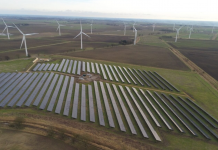Gross carbon emissions arising from Qatar’s supposedly ‘carbon neutral’ football World Cup, opening on 20 November, could be as much as five times FIFA’s claimed 3.6 million tonnes, new analysis claims.
In the week that corrupt former world soccer boss Sepp Blatter conceded it was a “mistake” that the tiny oil-rich emirate – population 3 million, only 15% of them native-born – should host the soccer World Cup, the organisers’ claims for the event’s supposed “carbon-neutrality” have come under re-newed questioning.
FIFA’s 2022 World Cup is being billed as the first carbon-neutral global soccer contest. FIFA estimates of 3.6 million tonnes of gross CO2e puts Qatar 2022 on a par with the 2016 Rio Olympics, and roughly equivalent to Iceland’s yearly emissions.
But the soccer fest’s gross CO2 emissions announced by the organisers before offsetting are, according to environmental analysts Greenly, higher than the two million tonnes declared for Russia 2014 and Brazil 2018. And Greenly reckon even 3 million tonnes underestimates and massages the true figure.
Advisors to corporate clients in the US, UK and France, the consultants say their tally of WC-related carbon activities encompasses the building or upgrading of eight stadia, plus fans’ accommodation and flights into and within the emirate, and even worldwide spectating via TV.
The Qatari emirate has promised to offset its emissions by buying carbon credits. According to Greenly, however, one month before the competition, 95% of the budgeted total is left unaccounted.
Seeking independent validation of its carbon estimates arising from new WC infrastructure, Qatar turned to the Global Carbon Council. Sustainability accountants Greenly describe the GCC as “a non-independent and non-internationally recognised body, with different criteria from other existing systems”.
Normand concedes difficulty in evaluating precisely the 2022 contest’s carbon footprint. “However, with our estimates alone, we are already close to 6 million tonnes of CO2e, which is almost double the emissions announced by Qatar” he said.
Aircon fails at 34 degrees in new stadium set for WC Final
Six entirely new stadiums are to be delivered for Qatar’s World Cup, all of them with new air-conditioning systems. One is set to be dismantled at the end of the competition.
According to Carbon Market Watch, a second consultancy quoted by Greenly, building the new stadiums has generated a carbon footprint eight times greater than FIFA’s estimate. The true figure is likely to be closer to a lifetime-adjusted 1.6 million tonnes CO2e, compared to 200,000 tonnes had the stadiums been used for 60 years of competitions.
“Even if air-conditioning systems installed are 40% more energy efficient than declared, these open-air stadiums can only be cooled using a considerable amount of supplementary energy”, say Greenly.
Air-conditioning reportedly broke down during a test match on 9 September in the Stade de Lusail, pictured, venue of the 2022 WC final, leaving 78,000 spectators in 34 degree heat. Queues of fans departing at half time reportedly stretched for 2 km to metro stations.
Greenly calculate the air travel of an expected 1.2 million fans to the Arabian Gulf countries during the contest could amount to around 2.4 million tonnes CO2e. Assuming these flights on Airbus A320s with 150 passengers per flight, 160 round trips between Doha and Dubai would amount to 2,160 tonnes of CO2e per person during the tournament.
Filled to 100%, per person emissions would amount to 2,880 tonnes, or 83,520 tonnes of CO2e per flight over the 29 days of the competition. Private jets used by dignitaries of the 32 delegations expected to attend would rack up more carbon pollution. Private jets can emit 14 times more CO2 per person than a seat on a scheduled flight.
Greenly estimate TV viewing over the Qatari competition’s 29 days will equal the 34.66 billion viewing hours estimated for the previous contest in Russia in 2018.
According to Total Energies, cited by Greenly, the average electricity consumption of an LCD television is 0.1 kWh per viewing hour. Given an average carbon intensity across the globe of 475 gCO2e/kWh, Greenly estimates the carbon footprint of broadcasting and related activities alone will be in the region of 1 to 2 million tonnes of CO2 equivalent.
“It is important to remember that these are but estimates, and thus, should not be taken at face value. However, it shows that figures announced by Qatar fall short of reality by a significant degree,” says Alexis Normand, CEO and co-founder of Greenly.
The Guardian reported in February 2021 that at least 6,500 migrant workers from the Indian sub-continent alone died in Qatar in the decade after 2010, when the oil-rich emirate secured FIFA’s blessing in to host this year’s tournament.
That 6,500 claim is disputed by Qatar. The state says only three workers have died in the new stadiums, but has published no figures relating to the state’s pre-WC building bonanza, buoyed by construction of a new airport, highways & scores of hotels.
And the Guardian figure excludes workers from the Philippines and Kenya, both of them swelling the state’s migrant work force. Liberalising reforms to Qatar’s punitive ‘kaffala’ system of indentured labour were brought in only in 2018. Campaigners such as Amnesty continue to complain of poor enforcement.
The tiny Gulf state is also accused by activists of ‘sportswashing’ its reputation for homophobia and its controversial human rights record.
In a week when Qatar’s ambassador to the World Cup, former Qatari international player Salman Khalid, described homosexuality as a ‘disease in the mind’, Australia’s national squad the Socceroos released a TikTok video slamming the state’s dismal human rights record.




